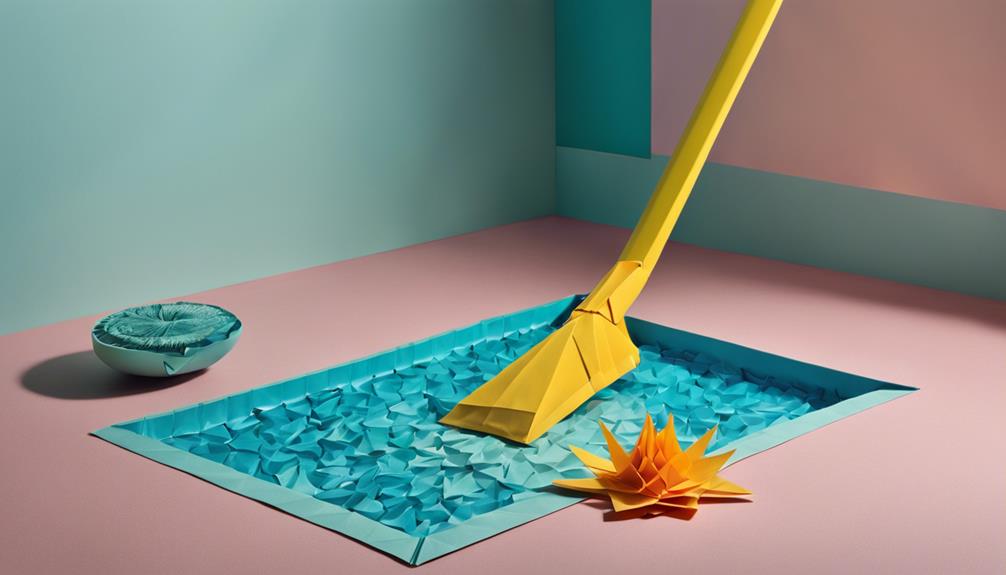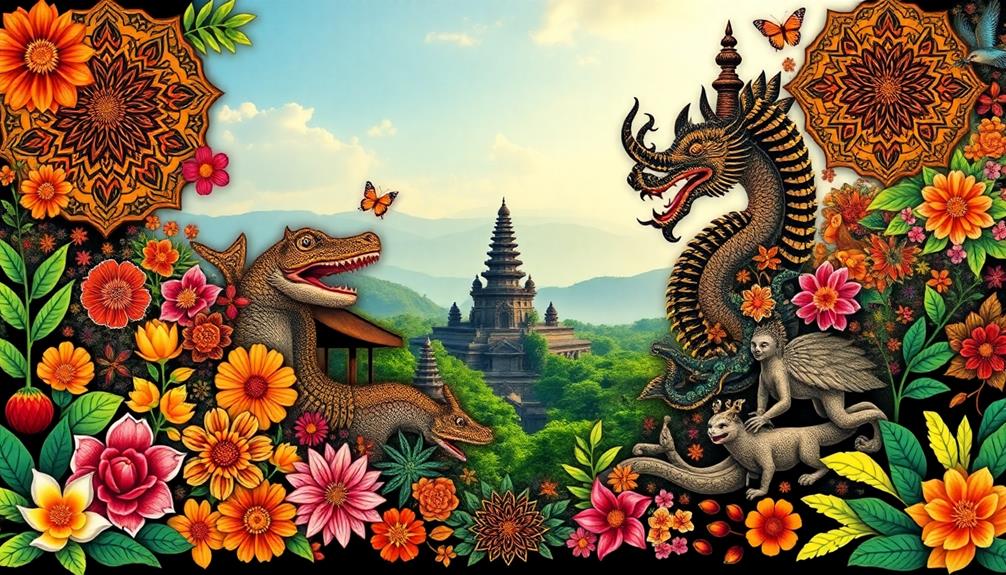Y2K room decor is all about vibrant colors and playful textures that turn your space into a nostalgic haven. Think pastel pinks, turquoise, and lime greens, paired with metallic accents for a modern twist. Add funky furniture like inflatable chairs or fuzzy bean bags for comfort. Don't forget lighting! Glow-in-the-dark sconces and disco ball pendant lights set the mood perfectly. For a finishing touch, sprinkle in glittery star wall stickers and soft faux fur rugs. This unique combo creates an energetic and creative atmosphere that encourages fun and relaxation. There's so much more you can explore for your Y2K vibe!
Key Elements

When creating your Y2K-inspired room, pay close attention to the color scheme, materials, and textures.
You'll want vibrant hues and playful patterns to bring that nostalgic vibe to life.
Incorporating the right elements will set the stage for a fun and inviting space.
Color Scheme
Embracing vibrant and pastel hues, a Y2K color scheme creates a whimsical atmosphere that instantly elevates your room decor.
You'll want to focus on shades like pink, turquoise, and lime green to capture that nostalgic yet modern vibe. Metallics like silver and gold can add a futuristic touch, enhancing the overall aesthetic of your Y2K Aesthetic Room.
Incorporating neon accents is essential, as they provide striking contrasts against the softer colors while contributing to that maximalist feel.
Don't shy away from bold patterns; checkerboards and swirls can complement your bright color palette and add visual interest. Mixing textures is also key—think plush rugs paired with graphic prints to create depth and character.
When choosing your color scheme, remember that the goal is to evoke a sense of nostalgia while keeping it fresh and exciting.
By carefully curating your colors and patterns, you'll create a space that feels both playful and inviting.
Materials
Incorporating vibrant textiles like velvet and faux fur brings a playful comfort to your Y2K-inspired room decor. These materials not only add warmth but also create a visually appealing aesthetic. Consider using bold patterns and graphic prints in your fabrics to further enhance the lively atmosphere.
Pair these vibrant textiles with Y2K furniture made from acrylic and glass, which infuse a light and airy feel into your space. Don't overlook the charm of inflatable furniture; chairs and ottomans in this style capture the fun, casual vibe of the early 2000s while being easy to store or rearrange.
For a touch of nostalgia, incorporate retro technology elements, like vintage electronics or nostalgic collectibles, as decorative accents. They serve as both functional pieces and conversation starters, reinforcing your Y2K theme.
Layer your textiles thoughtfully, mixing and matching colors and patterns to create a dynamic look. Remember, the key is to balance comfort with visual interest, ensuring your space feels inviting yet distinctly reflective of the Y2K era.
Embrace these materials, and watch your room transform into a nostalgic haven!
Textures
Textures are essential in Y2K room decor, bringing a lively mix of plush, shiny, and tactile elements that make your space feel both vibrant and inviting. To achieve this aesthetic, consider incorporating materials like plush velvet and faux fur. These soft textures add warmth and comfort, perfect for creating a cozy atmosphere.
Layering different textures is key. For instance, pair a plush velvet throw with a sleek acrylic chair to create visual interest. Don't shy away from bold graphic prints on textiles like throw pillows and bedspreads, as they enhance the playful vibe characteristic of Y2K design.
Adding shiny metallics can further amplify the eclectic feel of your room. Think about incorporating sequined or glittery accents, which evoke nostalgia while introducing a whimsical touch. Vintage textiles, such as quilted bedspreads or patterned curtains, can help balance out bright neons and pastels, grounding your decor.
Essential Fixtures and Furniture

When it comes to Y2K room decor, lighting plays an essential role in setting the vibe.
You'll want to take into account glow-in-the-dark wall sconces, disco ball pendant lights, and neon LED strip lights to create that nostalgic, vibrant atmosphere.
These fixtures not only brighten up your space but also add a fun and playful touch that defines the era.
Glow-In-The-Dark Wall Sconces
Adding glow-in-the-dark wall sconces brings a playful yet functional lighting option to your Y2K-inspired space, enhancing its whimsical charm. These sconces often come in fun shapes like stars, moons, or abstract designs, effortlessly complementing the vibrant color palette typical of Y2K decor.
As they utilize phosphorescent materials, they charge during the day and emit a soft, ambient light at night, creating a magical atmosphere that's perfect for relaxation or late-night hangouts.
Incorporating glow-in-the-dark wall sconces into your room decorations can elevate the entire aesthetic. Pair them with neon lights and retro posters for a cohesive nostalgic vibe that captures the essence of the early 2000s.
Whether you want to light up a reading nook or create a cozy corner for socializing, these sconces serve both function and fun.
Installation is straightforward, making it an easy DIY project that allows for personal creativity and expression.
Disco Ball Pendant Light
A disco ball pendant light instantly transforms your space into a lively focal point, reflecting light in dazzling patterns that capture the essence of Y2K fun. These striking fixtures serve as a dynamic element in room decor ideas, bringing energy and excitement to your environment. Available in various sizes, you can easily find the perfect disco ball to fit any room—whether it's a cozy nook or a more expansive area where you want to make a bold statement.
Many disco ball pendant lights use energy-efficient LED bulbs, providing vibrant illumination without compromising on eco-friendliness. You can enhance the ambiance further by pairing your disco ball with other lighting elements, like neon strips or fairy lights, to create a truly retro atmosphere.
The reflective surfaces of these lights complement metallic decor, such as acrylic furniture or shiny wall accents, reinforcing that retro-futuristic vibe characteristic of Y2K aesthetics. So, if you want to capture the playful spirit of the early 2000s in your space, incorporating a disco ball pendant light is a must!
Neon LED Strip Lights
To complement the lively energy of a disco ball pendant light, incorporating neon LED strip lights can elevate your Y2K room decor with vibrant colors and customizable lighting effects.
These lights are a must-have for adding an energetic atmosphere to your space. You can easily install neon LED strip lights along walls, furniture edges, or even ceilings, creating a striking outline that enhances the playful aesthetic of the era.
With various color options and remote control features, you can switch colors and adjust brightness to match your mood or occasion. This versatility allows you to transform your room for a chill night in or a lively gathering with friends. Additionally, think about designing creative shapes or whimsical patterns with the strips; they serve as both functional lighting and enchanting wall art.
One significant advantage of using neon LED strip lights in your interior design is their energy efficiency. They provide a long-lasting, cost-effective solution to achieve that nostalgic Y2K vibe without skyrocketing your energy bills.
Lighting Ideas

When it comes to lighting in your Y2K room, think about how you can create an energetic and nostalgic vibe.
You might consider incorporating fiber optic ceiling lights or color-changing LED floor lamps to bring a playful touch.
Don't forget the classic retro lava lamp glow for that perfect blend of fun and nostalgia!
Fiber Optic Ceiling Lights
Transform your space with fiber optic ceiling lights, creating a mesmerizing starry sky that enhances the whimsical vibe of any Y2K-themed room. These lights capture the essence of nostalgia while adding a modern twist, perfectly aligning with the vibrant aesthetics of Y2K Room Decor. Available in an array of colors, they let you mix and match to reflect the bold neons and soft pastels that define this iconic style.
Installation is a breeze, as fiber optic ceiling lights can be customized to fit various room shapes and sizes. This versatility guarantees you can create the ideal atmosphere, whether you want an intimate corner or a grand statement. Many options even come with remote controls, allowing you to easily change colors, brightness, and lighting modes to suit different moods and occasions.
Incorporating fiber optic lights not only adds a futuristic touch but also serves as a conversation starter, embodying the tech optimism of the Y2K era. So, light up your space with these stunning fixtures, and let your room reflect the playful spirit of Y2K!
Color-Changing LED Floor Lamps
Color-changing LED floor lamps offer an exciting way to elevate your Y2K-themed room with vibrant hues and customizable lighting options. These versatile lamps let you easily adjust colors, creating a dynamic ambiance that reflects your mood and style.
Whether you're hosting a retro-themed party or enjoying a chill night in your Y2K bedroom, you can set the perfect tone. Many color-changing LED floor lamps come with remote controls or smartphone apps, making it effortless to switch colors and brightness with just a few taps.
Some models even feature built-in color cycles, shifting through a spectrum that captures the playful spirit of Y2K decor. Imagine the nostalgic vibes as the colors dance around your room!
Beyond aesthetics, these lamps are energy-efficient, consuming less power than traditional bulbs, which is great for your wallet and the planet. Incorporating a color-changing LED floor lamp not only enhances the vibrant and eclectic design of your Y2K space but also adds both functionality and fun.
Pulsating LED Wall Panels
Pulsating LED wall panels are frequently a standout feature in Y2K decor, bringing your walls to life with dynamic colors and patterns that elevate the room's energy. These eye-catching panels offer a playful touch to your space, allowing you to customize colors and effects to match your vibe. You can easily sync them to music or set them to react to movement, creating an interactive experience that keeps the energy flowing.
With remote control options, adjusting brightness and colors is a breeze, so you can stay comfy while fine-tuning your ambiance. Plus, the LED technology guarantees energy efficiency, making these panels a sustainable choice for your vibrant Y2K aesthetic. They not only light up your space but also serve as a statement piece, complementing retro decor elements like neon signs or even a retro lava lamp.
Incorporating pulsating LED wall panels into your room will transform it into a dynamic haven, where every gathering feels alive and engaging. So go ahead, embrace this modern twist on Y2K decor and let your walls pulsate with personality!
Retro Lava Lamp Glow
Lava lamps consistently bring a nostalgic charm to any Y2K-inspired room, casting a warm, inviting glow that instantly enhances the atmosphere. Popularized in the 1960s and 70s, these iconic pieces are a staple in retro decor, known for their mesmerizing movement and soft ambient light. You can choose from various colors and styles, ensuring your lava lamp complements the bright neons or metallic finishes typical of Y2K aesthetics.
When you place a lava lamp strategically in your room, it can serve as both a focal point and a source of mood lighting. The gentle, swirling motion of the wax creates a calming effect, making them perfect for bedrooms or study spaces where you want to foster creativity or relaxation.
Consider pairing your lava lamp with other Y2K lighting elements, like neon strips or fairy lights, to amplify the eclectic ambiance. This combination not only emphasizes the playful, whimsical nature of the era but also transforms your space into a nostalgic haven.
Decorative Elements

To really capture that Y2K vibe, consider adding fuzzy bean bag chairs for a comfy touch.
Glittery star wall stickers can sprinkle some fun across your walls, while plastic inflatable furniture brings in a playful and nostalgic element.
These decorative pieces not only enhance your space but also reflect the quirky spirit of the early 2000s.
Fuzzy Bean Bag Chairs
Fuzzy bean bag chairs add a playful and inviting touch to your Y2K room decor, perfectly blending comfort with vibrant colors. These chairs, often crafted from soft materials like faux fur or plush fabric, provide a cozy seating option that embodies the whimsical spirit of the era.
Available in eye-catching hues such as pink, turquoise, and lime green, fuzzy bean bags are perfect for adding a pop of color to your room look while embracing the bright palette characteristic of Y2K design. Their casual, relaxed design allows you to use them in various ways—whether lounging, gaming, or simply enhancing your decor.
Plus, many fuzzy bean bag chairs are lightweight and portable, making it easy to rearrange your space to suit different activities or moods. Incorporating these chairs not only reflects the nostalgic vibe of the 2000s but also fosters a laid-back atmosphere that encourages creativity and social interaction.
Glittery Star Wall Stickers
Adding glittery star wall stickers can bring a celestial charm to your Y2K room decor, perfectly complementing the playful vibe created by fuzzy bean bag chairs. These stickers instantly elevate your space, adding a whimsical touch that captures the essence of Y2K aesthetics. Made from non-toxic materials, they're easy to apply and remove, making them an ideal choice for renters or anyone wanting a temporary decor solution.
Available in various colors, including metallics and pastels, glittery star wall stickers can seamlessly blend with the vibrant color palettes typical of this nostalgic design era. You can arrange them in playful patterns or clusters, allowing you to express your individual style and creativity.
Incorporating these decorative elements enhances the overall ambiance of your room, especially when paired with other nostalgic items like fairy lights and vintage posters. Whether you want to create a dreamy night-sky effect or a fun, energetic vibe, these stickers can truly make your room feel magical.
Plastic Inflatable Furniture
Plastic inflatable furniture brings a playful touch to your Y2K room decor, offering both style and comfort in vibrant colors and funky shapes. These lightweight pieces, which soared in popularity during the late 1990s and early 2000s, are perfect for adding a fun and casual vibe to your space. You can easily find inflatable chairs, couches, and ottomans that embody the whimsical spirit of early 2000s pop culture.
One of the best features of plastic inflatable furniture is its versatility. You can deflate and store these items conveniently, making them ideal for small spaces or temporary setups. Plus, their transparent or translucent materials often showcase vibrant patterns and finishes that align perfectly with the bold aesthetics of Y2K decor.
In addition to their decorative appeal, inflatable furniture also provides comfortable seating. Whether you're hosting friends, lounging, or just adding a splash of nostalgia to your room, these quirky pieces serve both form and function.
Embrace the lighthearted essence of Y2K decor with plastic inflatable furniture, and transform your space into a vibrant, nostalgic retreat!
Flooring

When it comes to flooring for your Y2K room, you've got some exciting options to evaluate.
Glossy vinyl tiles can create a sleek look, while faux fur area rugs add warmth and texture.
If you're feeling bold, metallic epoxy resin flooring can truly elevate the futuristic vibe you're aiming for.
Glossy Vinyl Tiles
Glossy vinyl tiles create a vibrant foundation for your Y2K-inspired space, reflecting the playful colors and dynamic energy of the early 2000s. These tiles boast a sleek, reflective surface that enhances the lively hues typical of Y2K decor. You can choose from a variety of colors and patterns, allowing you to mix and match styles while still capturing that nostalgic look. Whether you want a glossy finish that mimics wood or stone, you'll find options that align perfectly with your vision.
Durability is another significant advantage of glossy vinyl tiles. They're water-resistant and ideal for high-traffic areas, ensuring that your flooring stays looking fresh and vibrant over time. Plus, the installation process is DIY-friendly, so you can easily update your room's flooring without hiring professionals.
The shiny surface of these tiles also helps reflect light, creating a brighter and more inviting atmosphere. This feature is essential for capturing the essence of Y2K aesthetics, making your space feel alive and full of energy.
Faux Fur Area Rugs
Faux fur area rugs instantly transform your Y2K-inspired space, adding a touch of luxury and warmth that complements the vibrant decor. These rugs come in a variety of colors and patterns, perfectly matching the bright neons and pastels typical of the era. By incorporating faux fur, you enhance the playful atmosphere while introducing a cozy element to your room.
One of the best features of faux fur rugs is their practicality. They're easy to clean and maintain, making them a smart choice for high-traffic areas in your nostalgic space. Plus, the soft surface is incredibly comfortable underfoot, ideal for lounging areas or bedrooms styled in the Y2K theme.
Layering these rugs with other textiles, like graphic print throw pillows or patterned bedding, adds texture and visual interest to your decor. The combination of faux fur with bold design elements creates a dynamic look that draws the eye and keeps the vibe fun.
Metallic Epoxy Resin Flooring
Incorporating metallic epoxy resin flooring can elevate your Y2K room decor, creating a striking and reflective surface that enhances the vibrant atmosphere. This flooring choice is perfect for capturing the essence of pop culture from the early 2000s, as it brings a futuristic and edgy vibe to your space.
By mixing epoxy resin with metallic pigments, you can customize your flooring with eye-catching neons and shimmery tones that fit seamlessly into your nostalgic theme. Durable and resistant to wear, metallic epoxy resin flooring is ideal for high-traffic areas, ensuring your decor remains visually stunning over time.
The installation requires a smooth, clean surface and follows a multi-step process, including priming, pouring, and sealing to achieve that glossy finish you desire.
Maintenance is a breeze, as this non-porous flooring can be easily cleaned with mild soap and water, keeping it fresh and vibrant. With metallic epoxy resin flooring, you're not just enhancing your Y2K room decor; you're creating a space that resonates with the bold aesthetics of a beloved era while ensuring practicality in your daily life.
How Can I Incorporate Aesthetic Storage Options into my Y2K Room Decor?
Looking to revamp your Y2K room decor? Aesthetic storage solutions can be the perfect addition. Consider incorporating vintage-inspired shelves or colorful storage bins to keep your space organized while adding a touch of nostalgia. These stylish storage options will seamlessly blend with your Y2K aesthetic.
Conclusion
By incorporating these y2k room decor ideas, you can create a nostalgic space that feels uniquely yours.
Embrace the vibrant colors and quirky patterns of the early 2000s, and don't forget to add those essential fixtures and lighting that set the mood.
With the right decorative elements and flooring, you'll transform your room into a cozy, retro haven.
So, go ahead and let your creativity shine as you bring a piece of the past into your present!










